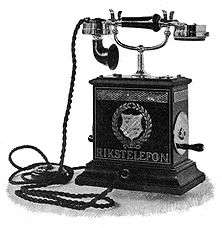Magneto
.png)
A magneto is an electrical generator that uses permanent magnets to produce periodic pulses of alternating current. Unlike a dynamo, a magneto does not contain a commutator to produce direct current. It is categorized as a form of alternator, although it is usually regarded as distinct from most other alternators, which use field coils rather than permanent magnets.
Hand-cranked magneto generators were used to provide ringing current in telephone systems. Magnetos were also adapted to produce pulses of high voltage in the ignition systems of some gasoline-powered internal combustion engines to provide power to the spark plugs.[1] Use of such ignition magnetos for ignition is now limited mainly to the following kinds of engines:
- Engines without a low-voltage electrical system, such as lawnmowers and chainsaws.
- Aircraft engines, in which keeping the ignition independent of the rest of the electrical system ensures that the engine continues running in the event of alternator or battery failure. For redundancy, virtually all piston engine aircraft are fitted with two magneto systems, each supplying power to one of two spark plugs in each cylinder.
Magnetos were used for specialized isolated power systems such as arc lamp systems or lighthouses, for which their simplicity was an advantage. Generators connected to an electrical grid for central station power generation do not use the magneto principle.
History
Production of electric current from a moving magnetic field was demonstrated by Faraday in 1831. The first machines to produce electric current from magnetism used permanent magnets; the dynamo machine, which used an electromagnet to produce the magnetic field, was developed later. The machine built by Hippolyte Pixii in 1832 used a rotating permanent magnet to induce alternating voltage in two fixed coils.[2]
Power generation
Magnetos have advantages of simplicity and reliability, but are limited in size owing to the magnetic flux available from their permanent magnets. The fixed excitation of a magneto made it difficult to control its terminal voltage or reactive power production when operating on a synchronized grid. This restricted their use for high-power applications. Power generation magnetos were limited to narrow fields, such as powering arc lamps or lighthouses, where their particular features of output stability or simple reliability were most valued.
Bicycles
One popular and common use of magnetos of today is for powering lights on bicycles. Most commonly a small magneto, termed a bottle dynamo, rubs against the tyre of the bicycle and generates power as the wheel turns. More expensive and less common but more efficient is the hub dynamo. Although commonly referred to as dynamos, both devices are in fact magnetos, producing alternating current as opposed to the direct current produced by a true dynamo.
Medical application
The magneto also had a medical application for treatment of mental illness in the beginnings of electromedicine. In 1850, Duchenne de Boulogne, a French doctor, developed and manufactured a magneto with a variable outer voltage and frequency, through varying revolutions by hand or varying the inductance of the two coils, for clinical experiments in neurology.
Ignition magnetos
Magnetos adapted to produce impulses of high voltage for spark plugs are used in the ignition systems of spark-ignition piston engines. Magnetos are used in piston aircraft engines for their reliability and simplicity, often in pairs. Motor sport vehicles such as motorcycles and snowmobiles may use magnetos because they are lighter in weight than an ignition system relying on a battery. Small internal combustion engines used for lawn mowers, chain saws, portable pumps and similar applications use magnetos for economy and weight reduction. Magnetos are not used in highway motor vehicles which have a cranking battery and which may require more control over ignition timing than is possible with a magneto system although sophisticated solid state controllers are becoming more prevalent.
Telephone

Manual telephones on local battery subscriber lines were equipped with a hand-cranked magneto generator to produce an alternating voltage to alert the central office operator, or to ring the bells of other telephones on the same (party) line.
See also
References
- ↑ Selimo Romeo Bottone (1907). Magnetos for Automobilists, how Made and how Used: A Handbook of Practical Instruction in the Manufacture and Adaptation of the Magneto to the Needs of the Motorist. C. Lockwood and son.
- ↑ Alfred Urbanitzky (Ritter von), Richard Wormell Electricity in the service of man: a popular and practical treatise on the applications of electricity in modern life, Cassell & Company, limited, 1886 p. 227, preview on Google books